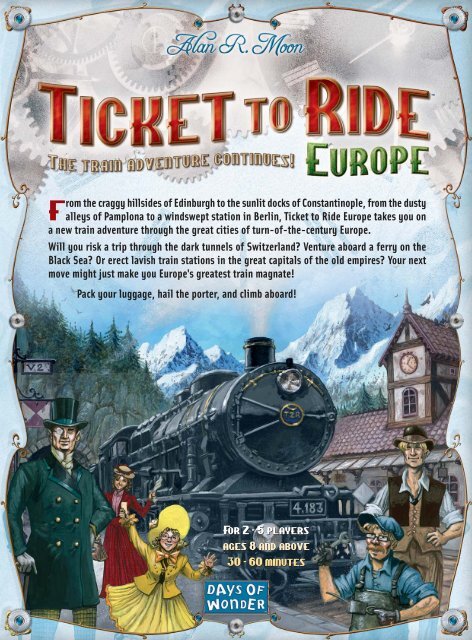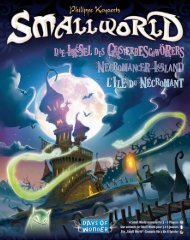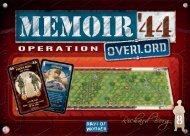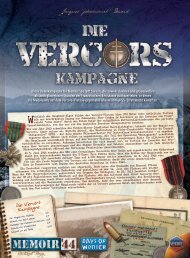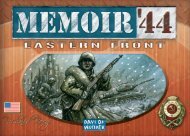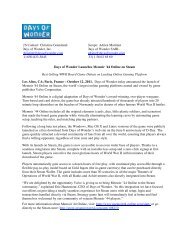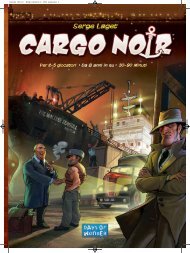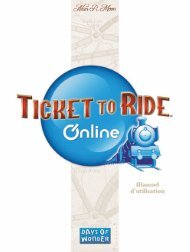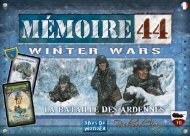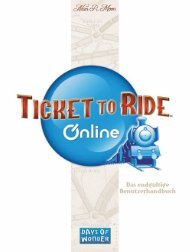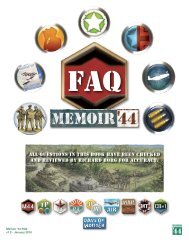Ticket to Ride Europe - Rules - Days of Wonder
Ticket to Ride Europe - Rules - Days of Wonder
Ticket to Ride Europe - Rules - Days of Wonder
You also want an ePaper? Increase the reach of your titles
YUMPU automatically turns print PDFs into web optimized ePapers that Google loves.
LocomotivesLocomotives are multi-colored, and act as wild cards in the game.Locomotive cards can be played along with any set <strong>of</strong> cards when claiming a route. They are also vital <strong>to</strong> claimingFerry routes (see Ferries).If a face-up Locomotive card is picked during a card draw, it must be the only card picked that turn. If a Locomotive is turned over as a replacementfor a first card drawn during the turn, or if a Locomotive is available face-up but not picked up as the first (and only) card, it cannot be selected asa second card.However, if a player is lucky enough <strong>to</strong> get a Locomotive from the <strong>to</strong>p <strong>of</strong> the deck in a blind draw, it still counts as a single card and he may still drawa <strong>to</strong>tal <strong>of</strong> two cards that turn.Claiming RoutesA route is a set <strong>of</strong> continuous colored spaces (in some instances, grayspaces) between two adjacent cities on the map. To claim a route, a playermust play a set <strong>of</strong> Train cards whose color and quantity match the colorand number <strong>of</strong> spaces <strong>of</strong> the chosen route.Most routes require a specific set <strong>of</strong> colored cards <strong>to</strong> claim them.Locomotives can always act as a stand-in for any given color (Seeexample 1).Routes that are Gray can be claimed using a set <strong>of</strong> cards <strong>of</strong> any one color(See example 2).When a route is claimed, the player places one <strong>of</strong> his plastic trains oneach <strong>of</strong> the spaces <strong>of</strong> the route. All the cards from the set used <strong>to</strong> claimthe route are then discarded. The player then immediately records hisscore by moving his Scoring Marker the appropriate number <strong>of</strong> spacesalong the Scoring Track, per the Route Scoring Table on page 7.A player may claim any open route on the board. He is never required <strong>to</strong>connect <strong>to</strong> any <strong>of</strong> his previously played routes.A route must be claimed in its entirety during a single turn. For example,you cannot lay two trains on a three-space route and wait for the nextturn <strong>to</strong> lay the third train.No more than one route may be claimed in a given player’s turn.Example 1orororTo claim a Blue route that is threespaces long, a player may play any<strong>of</strong> the following card combinations:three Blue cards;two Blue cards and a Locomotive;one Blue card and two Locomotives;or three Locomotives.Example 2ororA Gray route that is Two spaceslong can be claimed by playingtwo Red cards;one Yellow card and a Locomotive;or two Locomotives.Double-RoutesDouble - RoutesSome cities are connected by Double-Routes. These are routes whose spaces are parallel and equal innumber from one city <strong>to</strong> the other. One player can never claim both routes between the same cities duringthe course <strong>of</strong> the game.Be aware <strong>of</strong> routes that are partially parallel <strong>to</strong> each other but are linked <strong>to</strong> different cities. These arenot double-routes.parallel routesImportant Note: In two or three player games, only one <strong>of</strong> the Double-Routes can be used. A player can claim either<strong>of</strong> the two routes between cities, but the other route is then closed <strong>to</strong> the other players for the remainder <strong>of</strong> the game.4
FerriesFerries are special Gray routes linking two adjacent citiesacross a body <strong>of</strong> water. They are easily identified by theLocomotive icon(s) featured on at least one <strong>of</strong> the spacesmaking the route.To claim a Ferry Route, a player must play a Locomotive card for eachLocomotive symbol on the route, and the usual set <strong>of</strong> cards <strong>of</strong> the propercolor for the remaining spaces <strong>of</strong> that Ferry Route.Claiming the Ferry Route from Smyrna <strong>to</strong> Palermo requiresfour Train cards <strong>of</strong> any one color and two Locomotives.TunnelsTunnels are special routes that are easily identified by the special tunnel marks and outlinessurrounding each <strong>of</strong> their spaces.What makes a tunnel special is that a player is never quite certain just how long the route he istrying <strong>to</strong> claim will be!When attempting <strong>to</strong> claim a Tunnel route, a player first lays down the number <strong>of</strong> cards required by the length<strong>of</strong> the route. Then the three <strong>to</strong>p cards from the Train draw pile are turned face-up. For each card revealedwhose color matches the color <strong>of</strong> the cards played <strong>to</strong> claim the Tunnel, an additional card <strong>of</strong> the same color(or a Locomotive) must now be played from his hand. Only then can the player successfully claim theTunnel route.Two parallel tunnels - one Black andone White - link Madrid <strong>to</strong> Pamplona.If the player does not have enough additional Train cards <strong>of</strong> the matching color (or does not wish <strong>to</strong> play them), he may take all his cards back inhis hand, and his turn ends.At the end <strong>of</strong> the turn, the three Train cards revealed for the Tunnel are discarded.Remember that Locomotives are multi-colored wild cards. As such, any Locomotive card drawn from the <strong>to</strong>p <strong>of</strong> the Train draw pile during an attempt<strong>to</strong> go through a tunnel will au<strong>to</strong>matically match the color <strong>of</strong> the train cards played on the route, and force the player <strong>to</strong> play an additional card.If a player attempts <strong>to</strong> go through a Tunnel using Locomotive cards exclusively, he will only have <strong>to</strong> play additional cards (which must be additionalLocomotives in this case) if Locomotives show up among the three cards drawn for the Tunnel.In the rare event there is not enough cards available in the draw and discard piles <strong>to</strong> reveal 3 cards and determine the effect <strong>of</strong> the tunnel on a player,then only those cards that are available are revealed. If, as a result <strong>of</strong> players hoarding cards, there are none <strong>to</strong> be revealed, a tunnel can beclaimed without risking additional cards.Cards drawnCards drawnCards drawnExample 1Playing 2 red cards, 1 red card revealed :1 more red neededExample 2Playing 2 green cards played, 1 loco revealed :1 more green neededExample 3Playing 2 loco played, 1 loco revealed :1 more loco needed5
Drawing Destination <strong>Ticket</strong>sA player can use his turn <strong>to</strong> draw additional Destination <strong>Ticket</strong> cards. To do so, he draws three new cards from the<strong>to</strong>p <strong>of</strong> the Destination <strong>Ticket</strong> Deck. If there are less than three Destination <strong>Ticket</strong>s left in the deck, the player onlydraws the cards that are available.A player drawing <strong>Ticket</strong>s must keep at least one <strong>of</strong> them, but may choose <strong>to</strong> keep two, or all three. Any drawn <strong>Ticket</strong>not kept in hand is placed at the bot<strong>to</strong>m <strong>of</strong> the Destination <strong>Ticket</strong> Deck. <strong>Ticket</strong>s drawn and not immediately discardedmust be kept until the end <strong>of</strong> the game. They cannot be discarded during a later <strong>Ticket</strong> draw.The cities listed on a Destination <strong>Ticket</strong> represent travel goals for the player; they can result in a bonus or a penalty.If, by the end <strong>of</strong> the game, a player has created a continuous path <strong>of</strong> his color plastic trains between the twocities named on a Destination <strong>Ticket</strong> he holds, he scores the additional points indicated by the Point Value on the<strong>Ticket</strong>. If he has failed <strong>to</strong> complete a continuous path between those cities, he deducts the Point Value on the <strong>Ticket</strong>from his <strong>to</strong>tal score.Destination <strong>Ticket</strong>s are kept secret from other players until the game’s final scoring. A player may have any number <strong>of</strong> Destination <strong>Ticket</strong>s duringthe game.Building a train stationStationCostA Train Station allows its owner <strong>to</strong> use one, and only one, <strong>of</strong> the routes belonging<strong>to</strong> another player, in<strong>to</strong> (or out <strong>of</strong>) that city <strong>to</strong> help him connect the cities on his 1 st=To build his first Station, a player plays and discards one Train card from his hand,3 rdand places one <strong>of</strong> his colored Train Stations on the chosen city.To build a second=Destination <strong>Ticket</strong>s.Stations may be built on any unoccupied city, even if it currently has no claimed routesin<strong>to</strong> it. Two players may never build a Station in the same city.Each player may build a maximum <strong>of</strong> one Station per turn, and three Stations throughoutthe course <strong>of</strong> the game.2 d=Station, the player must play and discard a set <strong>of</strong> two cards <strong>of</strong> any one color; and <strong>to</strong>build his third, a set <strong>of</strong> three Train cards <strong>of</strong> any one color. As usual, you can replaceStation costany number <strong>of</strong> cards by Locomotives.If a player uses the same Station <strong>to</strong> help connect cities on several different <strong>Ticket</strong>s, he must use the same route in<strong>to</strong> the city with the Station for all<strong>of</strong> those <strong>Ticket</strong>s. The Train Station owner does not need <strong>to</strong> decide which route he will use until the end <strong>of</strong> the game.A player is never required <strong>to</strong> build any Stations. For each Station a player has not used, four points are added <strong>to</strong> his score at the end <strong>of</strong> the game.6
Game EndWhen any one player’s s<strong>to</strong>ck <strong>of</strong> colored plastic trains gets down <strong>to</strong> two trains or less at the end <strong>of</strong> his turn, each player,including that player, gets one final turn. The game then ends and players calculate their final scores.Calculating ScoresPlayers should have already accounted for the points theyearned as they completed various routes. To make sure nomistakes were made, you may want <strong>to</strong> recount the pointsfor each player’s routes.Players must then reveal all <strong>of</strong> their Destination <strong>Ticket</strong>s. Thevalue <strong>of</strong> successfully completed tickets is added <strong>to</strong> their<strong>to</strong>tal score. The value for any incomplete <strong>Ticket</strong>s is deductedfrom their <strong>to</strong>tal score.Remember that each Station played allows its owner <strong>to</strong> useone (and only one) route belonging <strong>to</strong> another player in<strong>to</strong>that City for the purpose <strong>of</strong> completing a Destination <strong>Ticket</strong>.If a player uses the same Station <strong>to</strong> help connect cities onthe paths <strong>of</strong> several different Destination <strong>Ticket</strong>s, he mustuse the same route in<strong>to</strong> or out <strong>of</strong> the city with the Stationfor all <strong>Ticket</strong>s.Route Length1234682 or less plastic trains ina player's s<strong>to</strong>ck signalthe final round <strong>of</strong> turns<strong>of</strong> the game.Points ScoredWhen a player claims a route, he immediately scores the number <strong>of</strong> points indicatedon the Route Scoring Table for the length <strong>of</strong> the route he just claimed.Add <strong>to</strong> the score <strong>of</strong> each player four points for each unplayed Station they still have in reserve.Finally, give the 10 point bonus for the <strong>Europe</strong>an Express <strong>to</strong> the player(s) who have the Longest Continuous Path on the board. When evaluating andcomparing path lengths, only take in<strong>to</strong> account continuous lines <strong>of</strong> plastic trains <strong>of</strong> the same color. A continuous path may include loops, and passthrough the same city several times, but a given plastic train may never be used twice in the same continuous path. Stations, and the opponents’routes they may provide access <strong>to</strong>, do not count for the purpose <strong>of</strong> computing paths and claiming the longest one. If several players are tied for thelongest path, they each receive the 10 points bonus from the <strong>Europe</strong>an Express card.The player with the most points wins the game. If two or more players are tied with the most points, the player who has completed the mostDestination <strong>Ticket</strong>s is the winner. If still tied, the player who used the least number <strong>of</strong> Stations is declared the winner. In the unlikely event playersare still tied, the player with the <strong>Europe</strong>an Express bonus card wins.12471521Current Score Destination ticket Bonus/Malus +4 Points/station kept <strong>Europe</strong>an Express bonus4 pointsEachFINALSCORECalculating final Score7
Online PlayHere is your <strong>Days</strong> <strong>of</strong> <strong>Wonder</strong> Online Access Number:To use it, simply visit www.ticket2ridegame.com and click on the New Player Signup but<strong>to</strong>n on the home page. Then just follow the instructions <strong>to</strong>join our incredible online community <strong>of</strong> players and test your skills against fellow players from around the world 24 hours a day.You can also discover our many other <strong>Days</strong> <strong>of</strong> <strong>Wonder</strong> games by visiting us on the web at www.days<strong>of</strong>wonder.comTable <strong>of</strong> contentComponents . . . . . . . . . . . . . . . . . . . . . . . . . . . . . . . . . . . . . . . . p.2Setting up the Game . . . . . . . . . . . . . . . . . . . . . . . . . . . . . . . . . . p.2Object <strong>of</strong> the Game . . . . . . . . . . . . . . . . . . . . . . . . . . . . . . . . . . . p.3The Game Turn . . . . . . . . . . . . . . . . . . . . . . . . . . . . . . . . . . . . . . . p.3— Drawing Train Cards . . . . . . . . . . . . . . . . . . . . . . . . . . . . . . . . p.3• Locomotives . . . . . . . . . . . . . . . . . . . . . . . . . . . . . . . . . . . p.4— Claiming Routes . . . . . . . . . . . . . . . . . . . . . . . . . . . . . . . . . . p.4• Double - Routes . . . . . . . . . . . . . . . . . . . . . . . . . . . . . . . . p.4• Ferries . . . . . . . . . . . . . . . . . . . . . . . . . . . . . . . . . . . . . . . p.5• Tunnels . . . . . . . . . . . . . . . . . . . . . . . . . . . . . . . . . . . . . . p.5— Drawing Destination <strong>Ticket</strong>s . . . . . . . . . . . . . . . . . . . . . . . . . . p.6— Building a train station . . . . . . . . . . . . . . . . . . . . . . . . . . . . . p.6Game End . . . . . . . . . . . . . . . . . . . . . . . . . . . . . . . . . . . . . . . . . . p.7Calculating Scores . . . . . . . . . . . . . . . . . . . . . . . . . . . . . . . . . . . . p.7Online Play . . . . . . . . . . . . . . . . . . . . . . . . . . . . . . . . . . . . . . . . . p.8CreditsGame design by Alan R. MoonIllustrations by Julien DelvalCopyright © 2004-2005 <strong>Days</strong> <strong>of</strong> <strong>Wonder</strong>, Inc. 199 First Street, Suite 340 Los Al<strong>to</strong>s, CA 94022<strong>Days</strong> <strong>of</strong> <strong>Wonder</strong> and <strong>Ticket</strong> <strong>to</strong> <strong>Ride</strong> are registered trademarks <strong>of</strong> <strong>Days</strong> <strong>of</strong> <strong>Wonder</strong>, Inc. All Rights Reserved.Geographical Note: We strove <strong>to</strong> accurately represent the political boundaries <strong>of</strong> <strong>Europe</strong> in 1901 and preserve the cities' common name in their local language at the time.For gameplay purposes however, we were forced <strong>to</strong> slightly adjust the position <strong>of</strong> certain cities on the map.We wish <strong>to</strong> thank the following play-testers for their contribution:Phil Alberg, Buzz Aldrich, Dave & Jenn Bernazzani, Pitt Crandlemire, Terry Egan,Brian Fealy, Dave Fontes, Tery Gaudet, Matt Horn, Craig Massey, Janet Moon, Mark Noseworthy,Michael Robert, Bob Scherer-Hoock, Mike Schloth, Eric Schultz, Scott Simon, Rob Simons,Adam Smiles, Tony Soltis, Richard Spoonts, Brian S<strong>to</strong>rmont, Rick Thornquistand everyone at <strong>Days</strong> <strong>of</strong> <strong>Wonder</strong>.8 7202-P07


